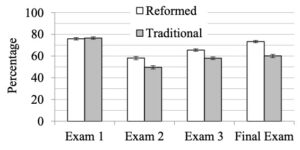It’s no secret that active learning helps students learn and retain more information than they would from traditional, lecture-only instruction. A new paper by Colin Wallace, a Teaching Associate Professor in our Department, and his colleagues at the University of Arizona, reveals the extent to which an entire semester of active learning benefits students. Their paper, which was just published in the Journal of College Science Teaching, describes a semester-long experiment comparing two introductory physics courses, one taught by an experienced and popular instructor who only lectured, and the other taught by a first-time instructor who made extensive use of active learning pedagogies.
Both classes enrolled over 200 students and covered the same content. Students in the two classes took identical exams. The first-time instructor sacrificed one of his three weekly lectures to make room for small breakout sessions of approximately 25 students each. During these breakout sessions, students worked collaboratively on activities informed by physics education research that were designed to improve student’s conceptual understandings and problem-solving skills. Additionally, the first-time instructor used the technique of Think-Pair-Share (a.k.a. Peer Instruction) in a novel way during lecture to improve students’ problem-solving skills.
The results were dramatic: On almost every question on every exam, students of the first-time instructor outperformed students of the experienced instructor. These results held for both conceptual and quantitative questions. By the final exam, students of the first-time instructor were outperforming their peers by as much as two letter grades on some questions. Because the final exam was a cumulative exam, this result suggests that the effects of active learning may be cumulative: As students spent more time actively engaged with the material, they experienced increased abilities to recall, apply, and synthesize what they learned, even in contexts that were prima facie novel.
The published paper is available at the following link: Students Taught by a First-Time Instructor Using Active-Learning Teaching Strategies Outperform Students Taught by a Highly-Regarded Traditional Instructor. A preprint version is available on the arXiv.

Average exam scores for both the traditional and reformed sections. Error bars represent the standard deviation of the mean.

